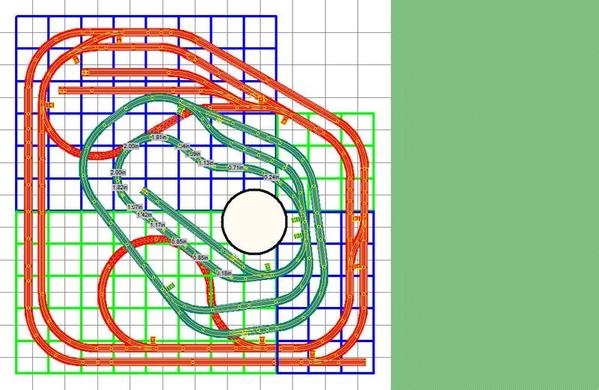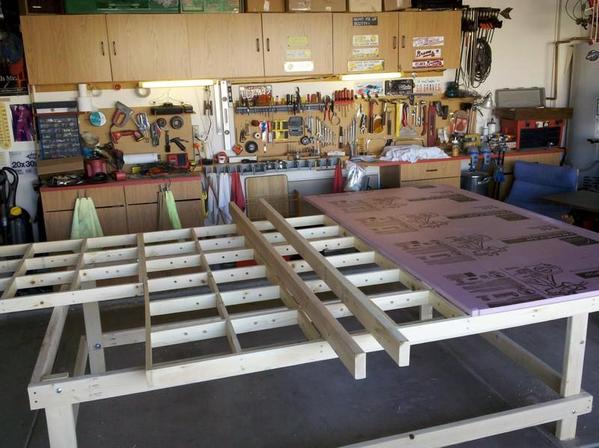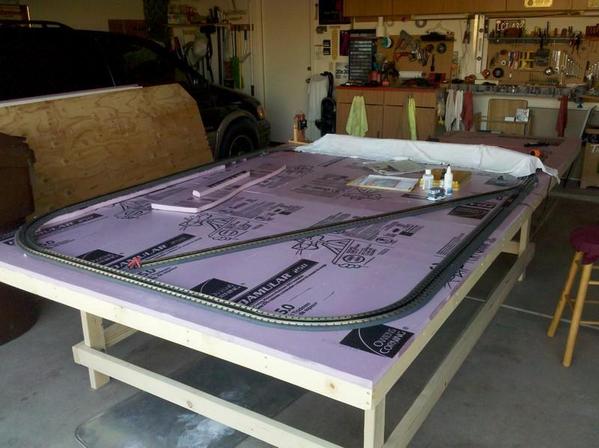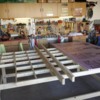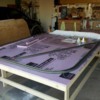Hi,
Like so many others, I started with a Lionel train set as a kid. I then toyed with N and HO guage layouts 40+ years ago, but never got past the track stage due to military moves. I tried to get back into N guage 2 years ago with a new Bachmann steam set, but decided it was just to small for me these days. So this year I decided to try my hand at O guage.
Over the past several days I came up with the above 11'x11' layout design w/42" curves (except for 31" curves for the inside oval on the upper level). The Blue/Green benchwork will be a 1' square grid of 1x3's covered with 1"-2" foam. This is a 2-level layout that wll have to come apart 3 times a year so I'm looking to reduce weight. The 6x9 upper level with simply lift off and the lower level will split at the east/west axis where the blue/green grids meet making one section 6x11 and the other 5x11. To make construction simpler, the two sections will be built in two parts that will be bolted together (upper blue/green and lower green/blue). The lower right corner has a lead to an optional 1x12 dual-track storage yard that will double as a display shelf. The circle represents an access hatch, but there will be others under the upper level. The 1' square grid is probably overkill, but I figured it can't hurt since I don't plan on using a plywood base. Eventually this will all be torn apart and moved to a spare bedroom, and be unfolded to become an around-the-room layout. The upper level would become a peninsula of sorts.
I do not enjoy switching and there is no particular theme I am trying to model. Scenery will probably be limited to desert-type landscape with faux buildings/mountains, probably not much more that murals around the upper level. I'm starting with RailKing's Christmas Steam Passenger Set w/DCS Proto-Sound 3.0 (http://www.mthtrains.com/content/30-4218-1) containing a 4-6-0 loco, tender and 3 passenger cars using RealTrax with 31" curves. Right now it's on a 4x8 sheet of 1/2" plywood just to get something running for Christmas and works for a simple oval. It will form the basis for the inside oval in the upper level. My goal is another steam and 2 diesels, and to be able to run 4 trains unattended using all tracks in both directions on the lower level and counter-clockwise on the upper level. When I convert this to around-the-room, I will get more into adding sidings and actual landscape. Until then, I think I've got enough switches, etc., to do as much switching as I want, even if I have to "pretend" some of the crossovers, etc., are sidings. ![]()
I'm expecting this to be a 3-year effort, mostly to obtain the track and rolling stock, and working around our travel schedule. First up is to build the benchwork, both levels. Next year I'll move the current oval to the inside oval on the upper level while I gradually obtain the tracks needed for the lower lever. I'll finish the lower level in 2014 and the rest of the upper in 2015.
I'm sure many of you are going to think this is too ambitious and access, particularly to some of the upper level tracks, is too limited. That is partly the reason for the multi-stage construction. I can remove the upper level for any major repairs and run it as an independent layout. I actually plan on the "legs" for the upper level to be adjust so I can raise the whole level for access to the lower level in the event of a major catastrophy and I even have some experience with layouts on pulley systems.
Okay, now for some questions I have:
Is the 1' grid with 2" of foam going to support things well enough? Would 1" foam be enough? I'm thinking 2" so I can cut out one layer for rivers/washes.
What is the best way to attach the track to the foam? Strategically placed double-sided tape? Long screws?
I like the RealTrax, but I'm concerned about things fitting exactly. I don't know how much flexibility there is to make the straight sections "connect".
I'm also concerned about cost. Is there a cheaper track I should consider? They make a converter track to link to standard track and I'm thinking of using those with some flextrack for the straight runs. I'm not even opposed to regular track right on the foam without a roadbed. I just want to run trains. ![]() I like the RealTrax switches because the mechanism can be positioned on either side and they auto-switch if I forget, but they aren't cheap.
I like the RealTrax switches because the mechanism can be positioned on either side and they auto-switch if I forget, but they aren't cheap.
I know I'll have to upgrade the transformer and remote that came with the set and run power to multiple parts of the track. What special wiring is needed? With DCS, do I need to wire in breaks for the reverse loops or crossovers like I did for N and HO?
Thanks in advance for any comments and help.




